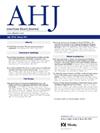Artificial intelligence-enabled electrocardiogram guidance for pulmonary valve replacement timing in repaired tetralogy of Fallot
IF 3.5
2区 医学
Q1 CARDIAC & CARDIOVASCULAR SYSTEMS
引用次数: 0
Abstract
Background
Optimal timing of pulmonary valve replacement (PVR) in repaired tetralogy of Fallot (rTOF) remains challenging. We hypothesized that pre-PVR artificial intelligence-enabled electrocardiogram (AI-ECG) may inform optimal PVR timing in rTOF.
Methods
rTOF PVR patients at Boston Children’s Hospital (BCH) and Toronto General Hospital (TGH) with analyzable ECGs ≤3 months pre-PVR were included. Patients undergoing PVR were propensity score-matched 1:1 to non-PVR patients. Patients were partitioned into risk tertiles based on pre-PVR AI-ECG probabilities of 5-year mortality: low-, intermediate-, and high-risk.
Results
The PVR cohort included 605 patients (504 at Boston Children’s Hospital (BCH), 101 at Toronto General Hospital (TGH); median age 20.3 [IQR, 13.6-32.0] years; median follow-up 7.5 [IQR, 4.7-10.6] years; 3.6% mortality). Pre-PVR AI-ECG risk probability was predictive of post-PVR mortality (c-index 0.77), outperforming an established imaging-based model benchmark (c-index 0.70). AI-ECG remained an independent predictor when added to the benchmark model (P < .001) with a higher c-index of 0.84. Survival was similar between low- and intermediate-risk groups (97-98% 15-year survival; P = .6), with increased mortality for the high-risk group (83% 15-year survival; P = .009). The matched cohort demonstrated that PVR was associated with increased survival overall (HR 0.28 [95% CI, 0.13-0.60], P = .001). Exploratory analyses stratified by risk group tertiles showed survival benefit associated with PVR in the intermediate-risk (HR 0.10 [95% CI, 0.01-0.86]; P = .04) and high-risk (HR 0.3 [0.1-0.7]; P = .005) groups, but not in the low-risk group (P = .8).
Conclusions
AI-ECG predicts post-PVR survival in rTOF patients with a PVR survival benefit in intermediate- and high-risk, but not low-risk, groups. AI-ECG may complement imaging biomarkers to determine rTOF PVR timing.
人工智能心电图指导修复后法洛四联症肺动脉瓣置换术时机。
背景:在修复的法洛四联症(rTOF)中,肺瓣膜置换术(PVR)的最佳时机仍然具有挑战性。我们假设PVR前的人工智能心电图(AI-ECG)可以为rTOF患者的最佳PVR时间提供信息。方法:纳入波士顿儿童医院(BCH)和多伦多综合医院(TGH)可分析心电图≤3个月PVR前的rTOF PVR患者。接受PVR的患者与非PVR患者的倾向评分匹配为1:1。根据pvr前的AI-ECG 5年死亡率概率将患者分为低、中、高风险三组。结果:PVR队列包括605例患者(BCH 504例,TGH 101例;中位年龄20.3 [IQR, 13.6-32.0]岁;中位随访7.5 [IQR, 4.7-10.6]岁;死亡率3.6%)。pvr前AI-ECG风险概率预测pvr后死亡率(c-index 0.77),优于已建立的基于成像的模型基准(c-index 0.70)。当加入基准模型时,AI-ECG仍然是一个独立的预测因子(pp结论:AI-ECG预测PVR后rTOF患者的生存,在中高风险组中PVR生存获益,而不是低风险组。AI-ECG可以补充成像生物标志物来确定rTOF PVR时间。
本文章由计算机程序翻译,如有差异,请以英文原文为准。
求助全文
约1分钟内获得全文
求助全文
来源期刊

American heart journal
医学-心血管系统
CiteScore
8.20
自引率
2.10%
发文量
214
审稿时长
38 days
期刊介绍:
The American Heart Journal will consider for publication suitable articles on topics pertaining to the broad discipline of cardiovascular disease. Our goal is to provide the reader primary investigation, scholarly review, and opinion concerning the practice of cardiovascular medicine. We especially encourage submission of 3 types of reports that are not frequently seen in cardiovascular journals: negative clinical studies, reports on study designs, and studies involving the organization of medical care. The Journal does not accept individual case reports or original articles involving bench laboratory or animal research.
 求助内容:
求助内容: 应助结果提醒方式:
应助结果提醒方式:


